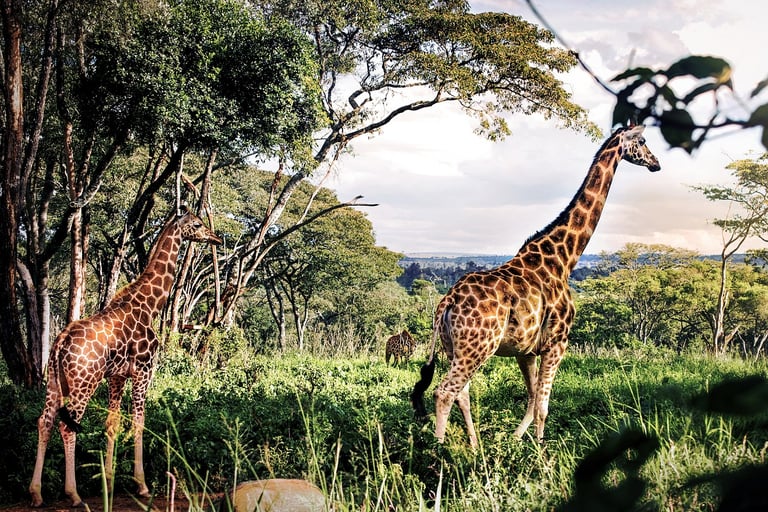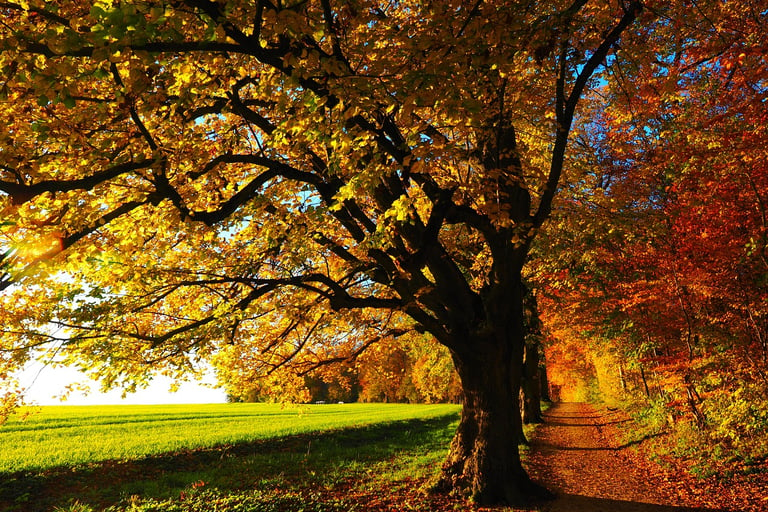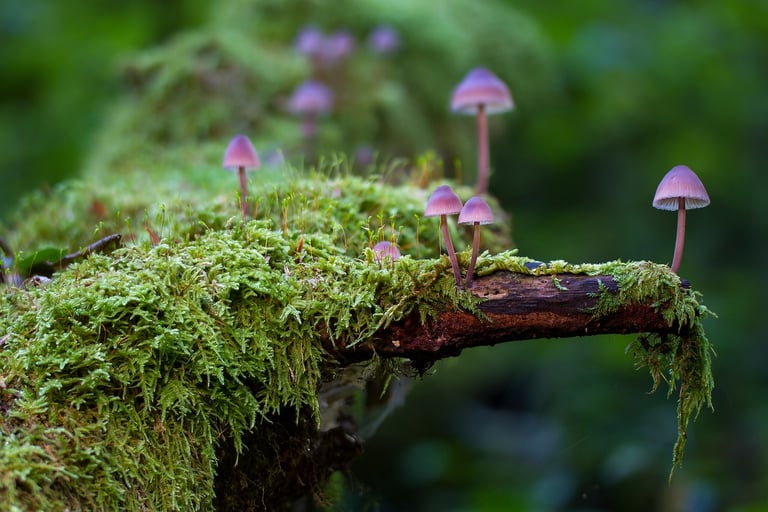The Forest’s Cycle: Beauty, Adaptation, and Survival
As sunlight weaves its golden threads through the emerald canopy, the forest awakens to the dance of the seasons—a passionate embrace of resilience and grace, where each rustle of leaves whispers a tale of hope and renewal.
GEOVISTA


The forest is a living tapestry, woven with roots that anchor the soil and branches that reach for light, forming an intricate web where each part depends on the others. To the casual eye, it may seem unchanging—a place of quiet and shadow. But observe closely, and the forest reveals a constant state of adaptation. Trees adjust their growth to capture sunlight, roots dig deeper in search of water, and creatures navigate this world with instincts honed by countless generations.
Then, as each season passes, the forest transforms entirely. Summer fills it with thick greenery and a pulse of life—leaves spread wide, undergrowth dense, and every corner alive with sound and movement. In autumn, that energy shifts. Leaves change colour, animals grow restless, and the forest seems to pause, preparing for leaner days. By winter, silence deepens as life retreats, conserving energy under bare branches and a cold sky. But spring is the forest’s renewal—a swift, urgent rebirth as fresh leaves unfurl and life returns to every corner, carrying on nature’s rhythm of endurance and change.
Each transformation tells a story of survival, adaptation, and interconnectedness as the seasons unfold. Let’s step into this enchanting world where every rustle of leaves and whisper of the wind reveals the artistry of nature’s cycles. Journey through these pages and discover how the forest breathes, adapts, and flourishes through the ebb and flow of the seasons.
Spring: Renewal and Growth
As the grip of winter loosens, the forest stirs, infused with a palpable energy that signals the return of life. Warmth seeps into the soil, coaxing dormant roots to awaken, while the gentle kiss of sunlight unfurls buds on branches that have patiently awaited this moment. The air, thick with the scent of damp earth and blossoming flora, teems with colour as wildflowers—frangipanis, marigolds, and bougainvillea—break through the underbrush, painting the ground in hues of gold, orange, and purple.
This season of revival brings forth a chorus of activity. Creatures long hidden from the world emerge, stretching in the bright light that now floods the forest. Slumbering snakes slink out of their lairs, soaking up the warmth, while monkeys swing playfully through the canopy, their calls echoing in the vibrant air. The forest is alive with the sounds of returning migratory birds—storks and cuckoos—each call weaving a tapestry of song that reverberates through the trees, heralding their homecoming and igniting the spirit of the forest.
In this thriving ecosystem, spring ignites a vital transformation. The once-bare trees now don a lush green attire, their leaves a feast for the myriad of insects buzzing around them. Bees flit from flower to flower, their delicate bodies dusted with pollen, while butterflies dance in the shafts of sunlight, each flutter a brushstroke on nature’s canvas. This harmonious awakening sets off a chain reaction; as blossoms open, they draw in butterflies and bees, nourishing the cycle of life that sustains the forest’s delicate balance. In every leaf unfurling and each creature that takes flight, nature’s resilience is on full display—a reminder that after the stillness of winter, life not only returns but flourishes, weaving a rich tapestry of renewal where growth and survival intertwine seamlessly.
Summer: Abundance and Activity
As spring fades, the forest shifts into summer, thick with life and green under the intense warmth of the season. The canopy grows dense, its leaves forming a protective roof that casts cool shadows on the forest floor. Vines and creepers cling to towering trunks, spreading across branches as if to claim every inch of sunlight. The air is thick and humid, filled with the scents of damp earth and vegetation, signs that the forest is thriving in this season of plenty.
Animals move with purpose in the warmth. Birds stay busy feeding their young hidden among the dense foliage, while squirrels dart from branch to branch, gathering food in anticipation of leaner months. The presence of predators is felt in the underbrush—leopards, snakes, and birds of prey, each waiting patiently, blending seamlessly with the thick summer greenery. Meanwhile, deer and other herbivores graze cautiously, aware of the heightened activity around them, every movement tuned to the rhythms of survival.
Summer brings abundance, and every creature seizes the moment. Herbivores feed on the green leaves and grasses, building reserves for the harsher seasons ahead, while predators sharpen their skills in pursuit of food that is plentiful but fleeting. Families grow close; herds and flocks form tighter bonds, each member learning and reinforcing survival tactics. As territories are marked and boundaries respected, this season of growth becomes one of preparation as well, with each creature’s efforts focused on the future.
In this season, the forest is at its most vibrant—a community of life all working together, each species contributing to the balance that sustains it. Summer is the forest at its peak, lush and alive, each creature attuned to the natural cycle that guides them.
Autumn: Preparation and Migration
As the forest reaches the height of its summer vitality, a subtle shift begins to whisper through the trees, signalling the approach of autumn. The vibrant greens of summer gradually yield to a stunning palette of golds, oranges, and browns, as leaves transform and flutter to the ground, creating a tapestry of colour beneath the canopy. The sun dips lower in the sky, casting a softer light that filters through the thinning foliage, transforming the forest into a realm of warmth and reflection.
Autumn becomes a time of harmony and balance, where the forest embraces the beauty of its transformation. With each falling leaf, the cycle of life continues, preparing for the stillness of winter that lies ahead. In this season, the forest stands resilient, a testament to the enduring spirit of nature, finding strength in both abundance and restraint.
In this season of preparation, animals respond to nature’s cues. Squirrels and chipmunks become busier, darting across the forest floor as they gather acorns and seeds, burying them in hidden spots for the winter months. Birds flock together, feeding on the last of the season’s bounty, while some embark on their long migrations, navigating by instinct toward warmer climates. The deer graze steadily, building their reserves as they instinctively know that leaner times are on the horizon.
Winter: Survival and Dormancy
As temperatures cool and days grow shorter, the forest itself begins to settle into a quieter rhythm. Every creature plays its part in this interconnected web of life, adapting to the changing environment and ensuring the survival of their species.
As winter unfolds in the forest, a serene stillness envelops the landscape, marking a time of quiet reflection. The air becomes crisp and cool, with gentle breezes whispering through the bare branches. The vibrant greens that once dominated the scenery fade into shades of brown and grey, as trees like the neem and banyan stand tall and skeletal against the clear, blue sky. Occasionally, a thin layer of frost coats the ground, glimmering softly in the morning light, adding a delicate beauty to the tranquil environment.
In this season, the art of survival reveals itself in the adaptations of the forest's inhabitants. The sloth bear seeks refuge in its den, relying on stored fat reserves to navigate the cold months ahead. Meanwhile, the majestic Indian flying fox flits through the twilight, foraging for the last remnants of fruit, while the agile mongoose scours the underbrush for hidden insects and small rodents. The starkness of winter encourages a quieter lifestyle, as the forest's rhythm shifts in harmony with the season.
Physical adaptations abound; as the temperature cools, the noble sambar deer dons a thicker coat, providing essential insulation against the brisk air. The once lush undergrowth recedes, and the trees conserve their energy, shedding leaves and entering a state of dormancy, preparing for the rejuvenation that spring promises.
Winter serves as a natural balance for the ecosystem, helping to regulate populations and ensure that only the hardiest survive. This time of dormancy is not just a period of waiting; it fosters resilience and diversity among the forest's inhabitants. The challenges of winter strengthen the bonds of life within the ecosystem, paving the way for a more vibrant rebirth in the seasons to come.
The forest flourishes as a vibrant ecosystem where every species, from towering trees to tiny insects, plays a crucial role in maintaining balance. This interconnectedness embodies nature's resilience, demonstrating how life thrives through cooperation and adaptation.
However, as we stand at the crossroads of environmental change, the importance of preserving these ecosystems becomes ever more urgent. Forests are not merely landscapes; they are living networks that support diverse life forms and provide essential resources for our planet. Protecting these vital habitats ensures that they can continue to adapt and thrive amidst shifting climates and human impacts.
By committing to the preservation of our forests, we honour the interconnectedness of all life and safeguard the legacy of resilience that has shaped these ecosystems for centuries. Together, we can nurture and protect these precious environments, allowing the beauty and vitality of forests to flourish for generations to come.
Subhalakshmi Buragohain
Hyderabad
Where every leaf is a story, and every path a journey within.


Sunshine, blossoms, and the magic of renewal.


Golden days, wild hearts awaken.


Golden hues and crisp air, nature’s farewell kiss.


Silent guardians, wrapped in winter’s white.


In the web of life, every creature has a role.
